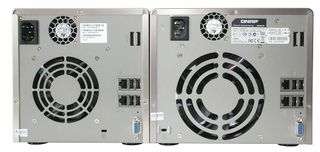Qnap TS-559 Pro: Do More Drives In Your NAS Mean More Speed?
We know that adding drives to a RAID array can help improve performance. But does adding storage to a NAS device really help push throughput higher? We put four-bay and five-bay units from Qnap up against each other and benchmark their transfer rates.
A Closer Look At The Devices
As mentioned, all models in the QNAP TS-x59 Pro series share the same dual-core Intel Atom D510 1.66GHz CPU and 1 GB of DDR2 RAM. The Intel NM10 Express chipset only provides two SATA ports, but the TS-449 Pro and TS-559 Pro are equipped with the Intel ICH9R controller as well, thus offering six additional SATA ports with AHCI support. The integrated power supply, two eSATA ports, four USB ports, and two Intel 8257L gigabit Ethernet controllers are available in all models.
Wider Design, Larger Fan

The fifth drive bay makes the TS-559 Pro housing a bit wider than that of the TS-459 Pro (21 cm and 18 cm, respectively). This allows for the use of a large 120 mm fan, compared to the 92 mm fan in the four-drive bay TS-459 Pro. We did not notice any significant differences in noise levels, though. The height (18.2 cm) and depth (23.5 cm) of the two units are identical, though the 5.1 kg TS-559 Pro is quite a bit heavier than the 3.6 kg TS-449 Pro.
(Almost) Identical Front Panels

The front panels of the two NAS units are almost identical. The only differences are the number of drive bays and the power LED to the left of the TS-559 Pro. Other than that, they share the same power button, One Touch Copy button, LCD display, enter/select switch, and status LEDs for eSATA, USB, LAN, and system state. The drive bays are identical as well.
Stay on the Cutting Edge
Join the experts who read Tom's Hardware for the inside track on enthusiast PC tech news — and have for over 25 years. We'll send breaking news and in-depth reviews of CPUs, GPUs, AI, maker hardware and more straight to your inbox.
Current page: A Closer Look At The Devices
Prev Page Roughly $170 USD Per Drive Bay Next Page Do More Hard Drives Equal Faster RAID?-
thomaseron "We put four-bay and five-bad units..."Reply
Haha! ;-)
EDIT: They have corrected it now... :-) -
Zoidman I set a TS-459 up at my work, and that machine is a piece of beauty! It runs a copy of linux on it which is root accessible by SSH thus unlocking all the potentials you could ever want! It adds a huge amount of value to the devices in my opinion and would recommend it to a business looking for a basic backup system.Reply -
ProDigit10 Who would want to pay that for a nas server?Reply
Just purchase a micro atx board + case + Atom N550/D525 and 2GB of ram, and install 2 or 4 harddrives in RAID.
It'll cost you less than $400!
5 drives and up is indeed harder to get, but definitely NOT worth trice the price!
Besides, the Atom is a very small CPU which would bottleneck when 2 or 3 drives are copy/moving data. I don't think it's even wise from performance standpoint of view to buy any Atom NAS server with more than 3 or 4 drives!
comment made before reading article. -
Agges Supporting ProDigit10's sentiment..Reply
How about adding a 'building your own NAS/server' guide, including testing the sweet-spot for price/performance for various set-ups..? -
mjw It looks like the network may be a bottleneck in a number of your tests. It would be interesting to see if the performance increases when the dual gigabit NICs are run in teaming mode.Reply -
KentC I bought an Acer Home Server with 4 hot swap drive bays and one drive bay with a 1tb drive with the server OS for $350. It looks like these units provide less and cost almost three times as much. Why are they so expensive? What does 3x the cost buy me?Reply -
joex444 I'm with mjw here. If the highest number you ever achieved is 116MB/s you're limited by GbE rather than anything else. When a 2 drive RAID1 performs the same as a 5 drive RAID5 you have some other problem.Reply
I run an external 8 bay unit, all drives filled with 2x250GB drives for OS and 6x750GB drives for RAID5. The biggest problem I have in terms of getting an idea of the true transfer rates capable is the fact that the RAID5 can write faster than the other array reads. And copying from an array to itself always has issues. So in real-world apps, my write speeds are limited by the read speed of other devices. The only logical way to untangle the two is to run a separate 6 drive RAID5 array, but I'm out of PCIe 8x slots to do so (as well as money). -
mikem_90 Part of what you pay for is the software development for all the features they give out of the box. Sure you could build your own, but it might not be as compact while offering hot swap and have an well designed interface with the well integrated features.Reply
These systems offer some very nice features I don't mind paying for.
Keep in mind that this is the corporate version, it has a much beefier CPU than the cheaper ones that cost a few hundred dollars less. They don't offer the same performance, but not everyone needs to use volume based encryption and send the files back and forth over SSL encrypted links.
Most Popular


